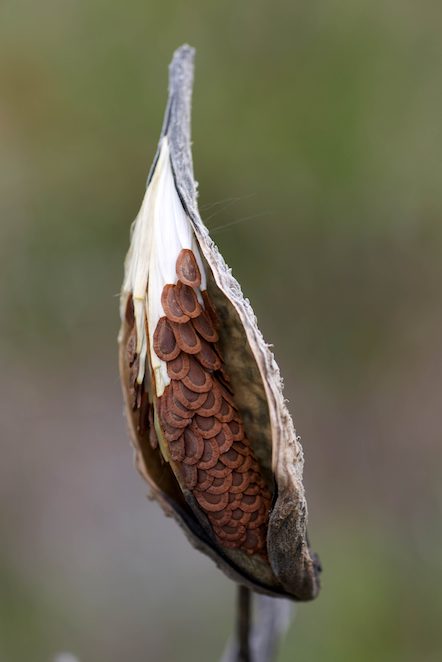Volunteer Seed Collectors Needed

Milkweed, Photo by Hagerty Ryan, USFWS on Pixnio
Georgian Bluffs, ON - A Greenbelt Foundation-funded project called Regenerate Grey Bruce (RGB) invites community members to participate in an emerging native plant value chain. RGB believes that “regeneration” is the action we can take together to respond to complex challenges between humans and living landscapes.
Practical action is urgently needed to regenerate Ontario’s natural world. Our landscapes are under threat from landscape simplification for housing development and industrial farming, from invasive species, and a changing climate. Native seeds collected from natural places are a limiting resource for regenerating nature as quickly as it's needed. An acute shortage of seed collectors was identified as a key challenge by a group of local stakeholders - native plant nurseries and other groups such as, conservation groups, Conservation Authorities, the Forest Gene Conservation Association (FGCA), and by Carolinian Canada’s Southern Ontario Seed Strategy. A native seed shortage affects tree seeds, shrubs, perennials, and grasses. We cannot restore the living world without one core resource: a strong supply of native seeds from plants that grow well and naturally here in Ontario and in Grey Bruce.
Regenerate Grey Bruce is a project that is currently working with native plant nurseries, local farmers, and the general public to establish a localized production chain for native seeds and plants. This production chain would entail creating a partnership network between landowners and volunteers as primary seed collectors, farmers as wholesale growers, and native plant nurseries as growers, plant retailers, design consultants, and workshop teachers.
We hope that landscapers will sell native seeds and plants once our supply is more robust, reliable and available.
What does native seed collection entail?
Collecting native seeds is a rewarding activity but also requires skill and dedication. Seed collectors need to identify a strong stand of native plants that they can access and monitor on a regular basis. Seed collectors need to have an interest to refine their observation skills, and time to regularly observe the maturity of seeds. Seed collection is usually limited to a narrow time window! Seed forecasting, as offered by Forest Gene Conservation Association, can help narrow down the time window, but ultimately collectors need to keep an eye on the plants in their specific microclimate. Most importantly, seed collectors need to go out and collect seeds and get them ready for storage.
Several steps in the seed collection process can be shared in the community. RGB is working on re-building these “collective” aspects of the native plant production chain, to ease the workload for seed collectors. We need volunteers to do the actual collection. Seed collectors will be a core pillar for a localized native plant value chain.
What are we asking?
We are looking for 10 – 15 curious individuals who are willing to participate in our emerging network seed collector. Participants would learn, sharpen their nature skills, and become part of an intergenerational local community of regenerators. The following would be expected from participants
- Take part in Forest Gene Conservation Association’s Seed Collectors Essentials Training (4-8hr time commitment, virtual ONLY, late April) or, if desired, in the more involved Full Certified Seed Collector Course (additional 10-14h including an in-person event in Barrie). Costs for the “Essentials” course are approx. $140 and would be carried by the participant. A full course with full certification would cost around $450.
- Identify stands of 1-5 different native plants that you can monitor and observe conveniently. We will need hundreds of varieties and prefer to mix seeds from different stands of the same species, for more diversity. This can be trees (from sugar maple to bur oaks), perennials (from swamp milkweed to Black-eyed Susan), or shrubs like Nine-bark or prickly rose.
- Collect and dry seeds for these plants.
Seed collectors are not expected to deal with seed cleaning and winter storage - this will be done centrally. We will then clean the seeds as needed, and store them centrally in a temperature- and moisture-controlled environment. Seeds will then be distributed to growers across the region.
The friendly staff at Regenerate Grey Bruce will give you advance access to the training, just connect with us at regenerategreybruce@gmail.com. We are also open to suggestions and ideas regarding the native plant value chain.
About Us
Many community members are actively working toward this shared goal of nurturing our region’s landscapes such that they remain biodiverse and resilient into the future.
The project Regenerate Grey Bruce is building a network of practitioners in landscape regeneration from our region, while formulating a narrative of hope for this region’s landscape in our changing climate. A new landscape narrative will require a collective effort of our community to change our relationship with the land, the way that we value the land’s ecological functioning, and even how we value the land and the creatures that inhabit it. We can only do this together as a community. The organizers include local farmers Thorsten Arnold and Madeline Marmor.
The hosting organization is The Sustainability Project, formerly known as Grey Bruce Sustainability Network. This not-for-profit brings together community members who reside in this region, the Traditional Territory of the Saugeen Ojibway Nation, who are dedicated to creating a culture of sustainability. Our board members are civic leaders and champions of at least one community project that creates positive change. Together we're learning about climate action, resilience to extreme weather, landscape regeneration, climate justice, food security, and the whole doughnut in doughnut economics.
The Greenbelt Foundation is supporting projects that increase plant cover in the Greenbelt & Niagara Escarpment.
